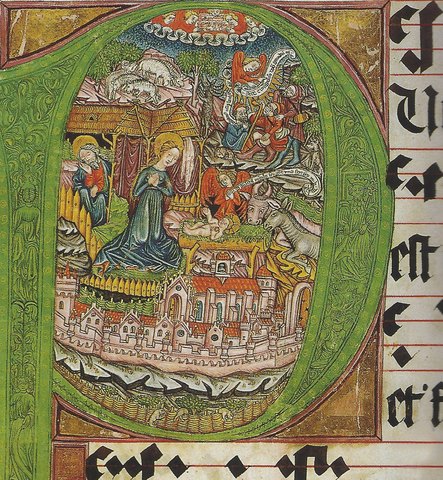A. Living rituals

Fig. Puer natus est nobis. Initial “P” (Introit Puer natus est nobis) in a Gradual written by Friedrich Zollner (c. 1442) in the Augustinian Abbey of Neustift/Novacella (province of Bozen/Bolzano). The historicised (narrative) initial marks the liturgy of the first Christmas Mass service. The angel at the crib is singing “In dulcis jubilo singet und seyt fro”.
In the contributions to this main topic, those traditions and elaborations of church rituals (the „liturgy“) which were characteristic of the region of Austria in the late Middle Ages are examined, even though their composers have remained largely unknown to us. In the metropolitan church province of Salzburg, Holy Week and Easter Sunday services were celebrated with special chants and processions. In Seckau Abbey and neighbouring locations, newly coined songs (tropes and cantiones) were added to the standard repertoire: these were forerunners of our modern-day church hymns. Rhythmicised plainchant (cantus fractus) came to adorn festive occasions in some places; indeed, the polyphonic performance of chant was not uncommon especially in monasteries. The specifically regional devotion to certain saints (for example St. Dorothy) led to the performance of religious plays and the creation of new chants for service and private prayer. Church ceremonies often made an appeal to lay piety; they were designed and disseminated in word, sound and image. Against an overly “secular” styling of the rite, a reform movement arose in the Benedictine Abbey of Melk. These demands for supraregional conformity and the simple dignity of liturgical chant became historically and aesthetically significant.
Osterfeier im Kloster
Stefan EngelsGesänge zu Weihnachten im Stift Seckau
Reinhard StrohmRhythmischer Choralgesang: Der cantus fractus
Marco GozziKlösterliche Mehrstimmigkeit. Grundlagen
Alexander RauschKlösterliche Mehrstimmigkeit. Arten und Kontexte
Reinhard StrohmDer Kremsmünsterer ludus de sancta dorothea (Spiel von der Hl. Dorothea)
Christian NeuhuberLaienfrömmigkeit: Die Rolle der Kirche
Ute Monika SchwobDie Melker Reform*
N.N.